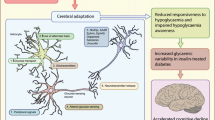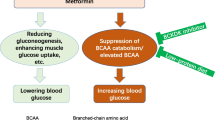Abstract
Metformin (Met), which is an insulin-sensitizer, decreases insulin resistance and fasting insulin levels. The precise molecular target of Met is unknown; however, several reports have shown an inhibitory effect on mitochondrial complex I of the electron transport chain (ETC), which is a related site for reactive oxygen species production. In addition to peripheral effects, Met is capable of crossing the blood–brain barrier, thus regulating the central mechanism involved in appetite control. The present study explores the effects of intracerebroventricular (i.c.v.) infusion of Met on ROS production on brain, insulin sensitivity and metabolic and oxidative stress outcomes in CF1 mice. Metformin (Met 50 and 100 µg) was injected i.c.v. in mice daily for 7 days; the brain mitochondrial H2O2 production, food intake, body weight and fat pads were evaluated. The basal production of H2O2 of isolated mitochondria from the hippocampus and hypothalamus was significantly increased by Met (100 µg). There was increased peripheral sensitivity to insulin (Met 100 µg) and glucose tolerance tests (Met 50 and 100 µg). Moreover, Met decreased food intake, body weight, body temperature, fat pads and survival rates. Additionally, Met (1, 4 or 10 mM) decreased mitochondrial viability and increased the production of H2O2 in neuronal cell cultures. In summary, our data indicate that a high dose of Met injected directly into the brain has remarkable neurotoxic effects, as evidenced by hypothermia, hypoglycemia, disrupted mitochondrial ETC flux and decreased survival rate.





Similar content being viewed by others
References
Viollet B, Guigas B, Garcia NS, Leclerc J, Foretz M, Andreelli F (2012) Cellular and molecular mechanisms of metformin: an overview. Clin Sci (Lond) 122:253–270
Adler AI, Shaw EJ, Stokes T, Ruiz F (2009) New drugs for control of blood glucose in type 2 diabetes: summary of the NICE guidelines. Praxis (Bern 1994). 98:1161–1163
Nathan DM, Buse JB, Davidson MB, Ferrannini E, Holman RR, Sherwin R, Zinman B (2009) Medical management of hyperglycemia in type 2 diabetes: a consensus algorithm for the initiation and adjustment of therapy: a consensus statement of the American Diabetes Association and the European Association for the Study of Diabetes. Diabetes Care 32:193–203
Gunton JE, Delhanty PJ, Takahashi S, Baxter RC (2003) Metformin rapidly increases insulin receptor activation in human liver and signals preferentially through insulin-receptor substrate-2. J Clin Endocrinol Metab 88:1323–1332
El-Mir MY, Nogueira V, Fontaine E, Averet N, Rigoulet M, Leverve X (2000) Dimethylbiguanide inhibits cell respiration via an indirect effect targeted on the respiratory chain complex I. J Biol Chem 275:223–228
Prakash R1, Johnson M, Fagan SC, Ergul A. (2013) Cerebral neovascularization and remodeling patterns in two different models of type 2 diabetes. PLoS One 8(2):e56264
Carvalho C, Correia S, Santos MS, Seiça R, Oliveira CR, Moreira PI (2008) Metformin promotes isolated rat liver mitochondria impairment. Mol Cell Biochem 308:75–83
Talbot K, Wang HY, Kazi H, Han LY, Bakshi KP, Stucky A, Fuino RL, Kawaguchi KR, Samoyedny AJ, Wilson RS, Arvanitakis Z, Schneider JA, Wolf BA, Bennett DA, Trojanowski JQ, Arnold SE (2012) Demonstrated brain insulin resistance in Alzheimer’s disease patients is associated with IGF-1 resistance, IRS-1 dysregulation, and cognitive decline. J Clin Invest 122:1316–1338
Reagan LP (2007) Insulin signaling effects on memory and mood. Curr Opin Pharmacol 7:633–637
Labuzek K, Suchy D, Gabryel B, Bielecka A, Liber S, Okopien B (2010) Quantification of metformin by the HPLC method in brain regions, cerebrospinal fluid and plasma of rats treated with lipopolysaccharide. Pharmacol Rep 62:956–965
Wilcock C, Wyre ND, Bailey CJ (1991) Subcellular distribution of metformin in rat liver. J Pharm Pharmacol 43:442–444
Petersen JS, Andersen D, Muntzel MS, Diemer NH, Holstein-Rathlou NH (2001) Intracerebroventricular metformin attenuates salt-induced hypertension in spontaneously hypertensive rats. Am J Hypertens 14:1116–1122
Lee CK, Choi YJ, Park SY, Kim JY, Won KC, Kim YW (2012) Intracerebroventricular injection of metformin induces anorexia in rats. Diabetes Metab J 36:293–299
Stevanovic D, Janjetovic K, Misirkic M, Vucicevic L, Sumarac-Dumanovic M, Micic D, Starcevic V, Trajkovic V (2012) Intracerebroventricular administration of metformin inhibits ghrelin-induced Hypothalamic AMP-kinase signalling and food intake. Neuroendocrinology 96:24–31
Park CR (2001) Cognitive effects of insulin in the central nervous system. Neurosci Biobehav Rev 25:311–323
Muller AP, Gnoatto J, Moreira JD, Zimmer ER, Haas CB, Lulhier F, Perry ML et al (2011) Exercise increases insulin signaling in the hippocampus: physiological effects and pharmacological impact of intracerebroventricular insulin administration in mice. Hippocampus 21:1082–1092
Grunblatt E, Salkovic-Petrisic M, Osmanovic J, Riederer P, Hoyer S (2007) Brain insulin system dysfunction in streptozotocin intracerebroventricularly treated rats generates hyperphosphorylated tau protein. J Neurochem 101:757–770
Menassol JB, Tautou C, Collet A, Chesneau D, Lomet D, Dupont J, Malpaux B, Scaramuzzi RJ (2011) The effect of an intracerebroventricular injection of metformin or AICAR on the plasma concentrations of melatonin in the ewe: potential involvement of AMPK? BMC Neurosci. 12:76. doi:10.1186/1471-2202-12-76
Parekh PI, Petro AE, Tiller JM, Feinglos MN, Surwit RS (1998) Reversal of diet-induced obesity and diabetes in C57BL/6J mice. Metabolism 47:1089–1096
Muller AP, Tort AH, Gnoatto J, Moreira JD, Vinade ER, Perry ML, Souza DO et al (2010) Metabolic and behavioral effects of chronic olanzapine treatment and cafeteria diet in rats. Behav Pharmacol 21:668–675
Berleze KJ, Muller AP, Schweigert ID, Longoni A, Sordi F, de Assis AM, Rotta LN et al (2009) Gestational and postnatal low protein diet alters insulin sensitivity in female rats. Exp Biol Med (Maywood) 234:1437–1444
Muller AP, Zimmer ER, Kalinine E, Haas CB, Oses JP, de Assis AM, Galina A et al (2012) Physical exercise exacerbates memory deficits induced by intracerebroventricular STZ but improves insulin regulation of H(2)O(2) production in mice synaptosomes. J Alzheimers Dis 30:889–898
Brewer GJ, Torricelli JR, Evege EK, Price PJ (1993) Optimized survival of hippocampal neurons in B27-supplemented Neurobasal, a new serum-free medium combination. J Neurosci Res 35:567–576
Williams T, Courchet J, Viollet B, Brenman JE, Polleux F (2011) AMP-activated protein kinase (AMPK) activity is not required for neuronal development but regulates axogenesis during metabolic stress. Proc Natl Acad Sci 108:5849–5854
Moreira JD, Knorr L, Thomazi AP, Simao F, Battu C, Oses JP, Gottfried C et al (2010) Dietary omega-3 fatty acids attenuate cellular damage after a hippocampal ischemic insult in adult rats. J Nutr Biochem 21:351–356
da-Silva WS, Gomez-Puyou A, de Gomez-Puyou MT, Moreno-Sanchez R, De Felice FG, de Meis L, Oliveira MF et al (2004) Mitochondrial bound hexokinase activity as a preventive antioxidant defense: steady-state ADP formation as a regulatory mechanism of membrane potential and reactive oxygen species generation in mitochondria. J Biol Chem 279:39846–39855
Boveris A (1984) Determination of the production of superoxide radicals and hydrogen peroxide in mitochondria. Methods Enzymol 105:429–435
Wendel A (1981) Glutathione peroxidase. Methods Enzymol 77:325–333
Lv WS, Wen JP, Li L, Sun RX, Wang J, Xian YX, Cao CX et al (2012) The effect of metformin on food intake and its potential role in hypothalamic regulation in obese diabetic rats. Brain Res 1444:11–19
Gropp E, Shanabrough M, Borok E, Xu AW, Janoschek R, Buch T, Plum L et al (2005) Agouti-related peptide-expressing neurons are mandatory for feeding. Nat Neurosci 8:1289–1291
Luna B, Feinglos MN (2001) Oral agents in the management of type 2 diabetes mellitus. Am Fam Physician 63:1747–1756
Petersen JS, DiBona GF (1996) Acute sympathoinhibitory actions of metformin in spontaneously hypertensive rats. Hypertension 27:619–625
Trammell RA, Toth LA (2011) Markers for predicting death as an outcome for mice used in infectious disease research. Comp Med 61:492–498
Whitaker AM, Sulzer J, Walker E, Mathis K, Molina PE (2010) Sympathetic modulation of the host defense response to infectious challenge during recovery from hemorrhage. Neuroimmunomodulation 17:349–358
Acknowledgments
This work was supported by Brazilian agencies and grants: CNPq, CAPES 02/2102, FAPERGS0543/12-4-PPSUS, Brazil-Swiss 590011/2010-3, Brazilian Institute of Neuroscience-IBN Net FINEP, INCT-Excitotoxicity and Neuroprotection.
Conflict of interest
The authors declare that they have no financial conflicts of interest.
Author information
Authors and Affiliations
Corresponding author
Rights and permissions
About this article
Cite this article
Portela, L.V., Gnoatto, J., Wigner Brochier, A. et al. Intracerebroventricular Metformin Decreases Body Weight But Has Pro-oxidant Effects and Decreases Survival. Neurochem Res 40, 514–523 (2015). https://doi.org/10.1007/s11064-014-1496-7
Received:
Revised:
Accepted:
Published:
Issue Date:
DOI: https://doi.org/10.1007/s11064-014-1496-7




